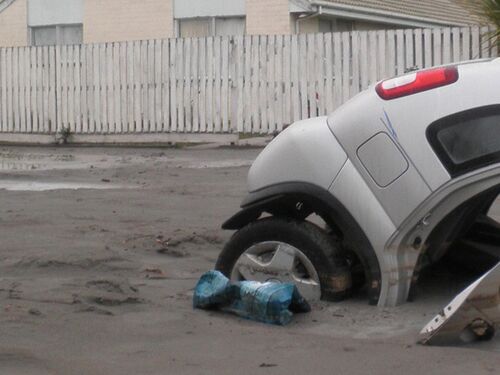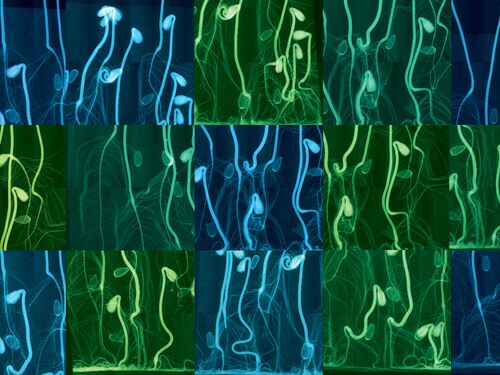Can earthquakes liquefy soil?
Based on Science
Some earthquakes can cause the ground to behave like a thick liquid. Soil liquefaction is a leading cause of earthquake damage worldwide.
Last update May 24, 2022
How does an earthquake make soil behave like a liquid?
Have you ever wiggled your feet in wet sand at the beach? As you move, the sand turns from a solid surface into gloopy muck that soon covers your toes. This is soil liquefaction at a small scale. The same thing happens in some earthquakes at larger scales.
A soil behaves like a firm solid when the weight of each soil particle rests on the soil particles below. Water can fill the gaps in between the soil grains. When the ground shakes, the soil grains can shift and lose contact with each other. In this state, the soil grains are suspended in the water and therefore the soil behaves like a thick liquid. Eventually, the soil grains settle down, coming back into contact with each other, and the soil hardens again.
For soil to behave like a liquid, three conditions need to exist. First, the soil needs to be granular, for example, composed of sands or gravels. Second, that soil must be saturated with water. And third, the earth needs to shake. Some places are more likely to have all the necessary conditions than others. Flood plains, beaches, and riverbanks are examples of places where these three conditions may be met. Many constructed earth fills―that is, where people have made soil deposits―are also susceptible to liquefaction.
Earthquake-induced liquefaction can be very dangerous.
When earthquakes cause liquefaction, things that are on top of or in the soil may move or sink. They then get stuck in their new position as the soil re-hardens.
Liquefaction can trigger landslides, cause embankments to slump, and cause buildings to sink into the ground and tilt, cars to be swallowed into the ground, and roads and bridges to crack and fail. Although scientists only became aware of the phenomenon in the 1960s, there is evidence that liquefaction occurred in many past earthquakes. For example, scientists found that liquefaction during the 1906 San Francisco earthquake damaged the city’s water pipes—one reason why firefighters were unable to effectively battle fires caused by the quake. More recently, in the early 2010s, about 15,000 homes had to be demolished after liquefaction damaged them beyond repair in two earthquakes in Christchurch, New Zealand. There are even events described in the Bible that are thought to have been caused by soil liquefaction.
Scientists and engineers are studying ways to reduce the risks.
Researchers have learned a lot about liquefaction over the past few decades. To reduce the risks, it is important to:
Understand where and when liquefaction is likely to happen,
Understand how liquefaction will behave when it occurs,
Predict how liquefaction will affect buildings and infrastructure,
Find ways to protect buildings and infrastructure from these effects, and
Develop ways to prevent soil liquefaction from occurring.
Scientists and engineers use experiments, computer simulations, and real-world observations to understand where liquefaction is likely to happen. For example, researchers have found that soils must be fully saturated with water in order to liquefy. Earthquakes must also reach a certain strength in order to trigger liquefaction, though the threshold varies depending on the nature of the soil. Scientists estimate that large areas of the United States have the potential for soil liquefaction. It is also important to understand how liquefied soil will behave and how this will affect structures atop and in it. For example, will the soil mostly stay in place or flow downhill? Will it still support structures, or will the structures move or sink? How can the soil be improved or altered so that it will not liquefy? To answer these questions, scientists can use experiments and simulations to make predictions. No method is perfect, but the findings can offer clues about where liquefaction poses the biggest risks. In places with a high risk of liquefaction, engineers can strengthen new and existing infrastructure to reduce the impacts. Such strategies have already proved valuable. For example, parts of a runway at Japan’s Sendai Airport were strengthened in 2008 to better withstand soil liquefaction. Just a few years later in 2011, the strengthened part of runway withstood damage from liquefaction when a powerful earthquake struck the region.
More research would improve our ability to predict and plan for soil liquefaction.
Experts say more research is needed to predict the effects of liquefaction and inform engineering decisions. The costs of damage from liquefaction can be enormous, but it can also be costly to build structures that are more earthquake-resistant than they need to be. Having better information can inform responsible and cost-effective decisions. Specifically, identifying places where liquefaction is likely and establishing field observatories before an earthquake strikes would help. That way, after an earthquake, scientists would have accurate information about what the soil properties were before liquefaction occurred. Large, publicly accessible databases containing information on past instances of liquefaction and their effects on the built environment would also help scientists develop, calibrate, and validate various approaches to predicting the triggers and consequences of liquefaction.




